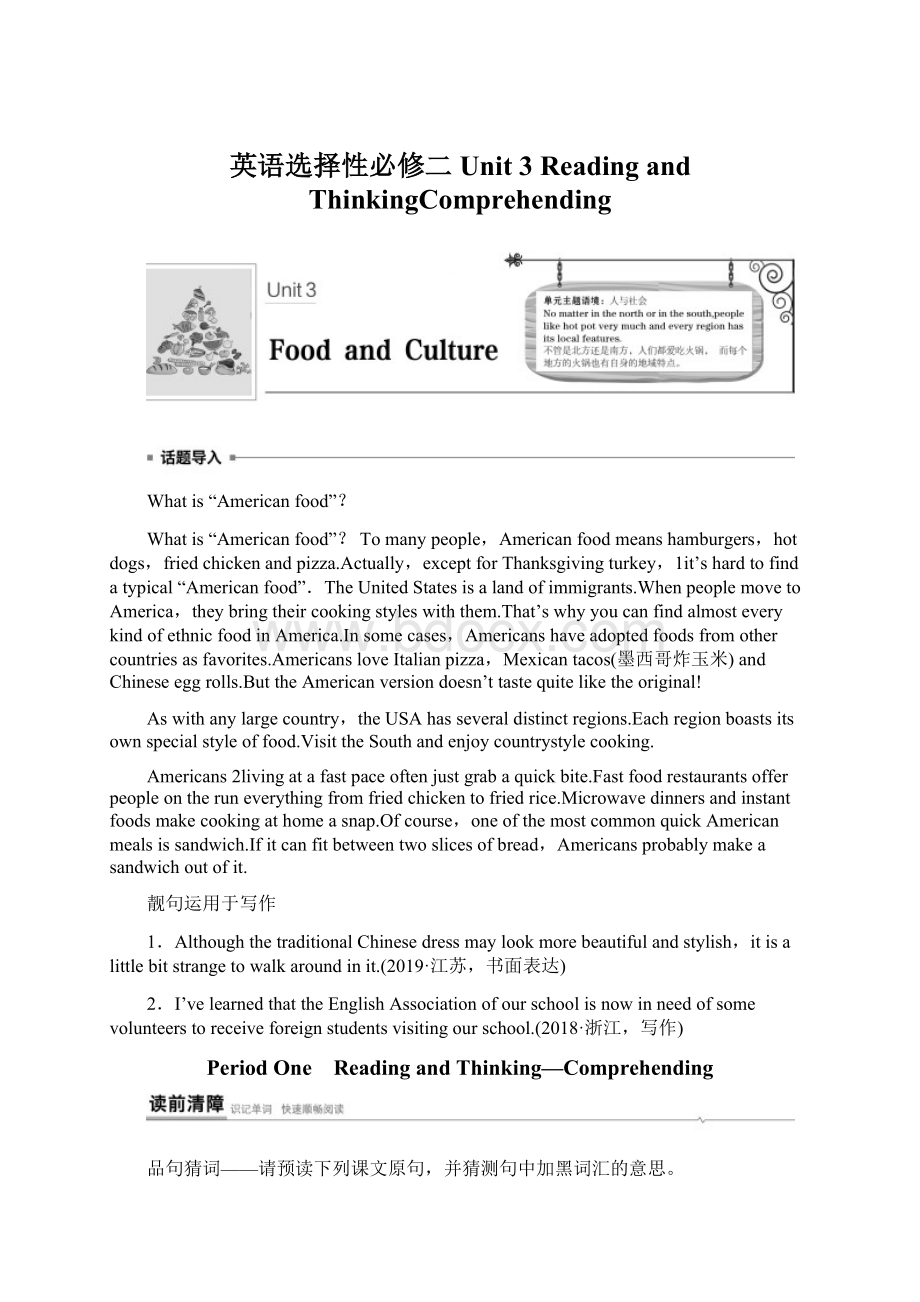 英语选择性必修二Unit 3Reading and ThinkingComprehending文档格式.docx
英语选择性必修二Unit 3Reading and ThinkingComprehending文档格式.docx
- 文档编号:21802413
- 上传时间:2023-02-01
- 格式:DOCX
- 页数:11
- 大小:77.30KB
英语选择性必修二Unit 3Reading and ThinkingComprehending文档格式.docx
《英语选择性必修二Unit 3Reading and ThinkingComprehending文档格式.docx》由会员分享,可在线阅读,更多相关《英语选择性必修二Unit 3Reading and ThinkingComprehending文档格式.docx(11页珍藏版)》请在冰豆网上搜索。

2.ThisisprobablynotanauthenticChineserecipe,however,soitcannottellusmuchabouttheChinese.烹饪法;
食谱
3.Later,IlearntthatthemostfamousfoodinShandongispancakerollsstuffedwithslicedChinesegreenonions.填满切成薄片的大葱
4.Ineachplacewewent,weexperiencedwonderfullocaldishes,fromGuangdong’selegantdimsum—smallservingsoffoodinbamboosteamers—totheexceptionalstewednoodlesinHenan.
精美的;
讲究的特别的
5.Ataminimum,thekindsoffoodlocalpeopleconsumetelluswhattheygrowintheirregion,whatkindsoflivestheylead,andwhattheylikeanddonotlike.最低限度;
最少量吃
1.What’sthemainideaofthepassage?
A.Youarewhatyoueat.
B.MostfamousfoodsinChina.
C.MyexperiencesoffoodandcultureinChina.
D.MyexcitingjourneyinChina.
答案 C
2.Readthepassageandmatchthemainideaofeachpart.
Para.1 A.Cultureandcuisinegohandinhand.
Para.2B.Youarewhatyoueat.
Paras.3-6C.MyexperienceofChinesefoodinAmerica.
Para.7D.MychancetoexperienceauthenticChinesefoodindifferentpartsofChina.
答案 Para.1 B Para.2 C Paras.3-6 D Para.7 A
Readthepassagecarefullyandchoosethebestanswer.
1.Accordingtothepassage,whatcan’tbeshowninthefoodyoueat?
A.Yourpersonality.
B.Yourfigure.
C.Yourcharacter.
D.Yourculture.
答案 B
2.Putthefollowingplacesthattheauthorhadbeentointimeorder.
①Xinjiang ②Henan ③Shandong ④Beijing ⑤Guandong
A.④③①⑤②B.②③⑤④①
C.④②①⑤③D.②⑤④③①
答案 A
3.WhatisthemostfamousfoodinShandong?
A.Boileddumplings.
B.Roastedmeat.
C.Stewednoodles.
D.Pancakerolls.
答案 D
4.WhydopeopleinXinjiangprefertheirfoodtobecookedoveranopenfire?
A.Becausetheyliketheflavourofboiledorroastedmeat.
B.Becausetheytraditionallywanderedtheopenrangeonhorses.
C.Becausethatwayofcookingcanbringthepeopletogether.
D.Becausethatwayofcookingcanshowtheircharacter.
5.Whatistheauthor’sopinionaboutcultureandcuisine?
A.Cuisinehasnothingtodowithculture.
B.Thefoodsapersoneatscanreflecthispersonalityvividly.
C.Cultureandcuisinearecloselyrelatedtoeachother.
D.Cuisineonlyshowswhatpeoplegroworraiseintheirregion.
Afterreadingthepassage,pleasefillinthefollowingblanks.
TheFrenchauthorJeanAnthelmeBrillat Savarinoncewrote,“Tellmewhatyoueat,andIwilltellyouwhatyouare,”1.whichmeans“Youarewhatyoueat.”Infact,Brillat Savarinwasactually2.referring(refer)toourpersonality,character,andculture.Inmanyways,thisseemstobetrue.Chinesecuisineisacaseinpoint.Chinaisacountrywithvast3.areas(area)andalargepopulation.Sothefoodisas4.varied(vary)asthepeople.Forexample,peopleinShandonglikeboileddumplings5.served(serve)withvinegar,becausetheprocessofmakingdumplingscanbringthefamilymemberstogether.6.Traditionally(traditional),peopleinXinjiangspentmostoftheirtimeonhorsebacks,andthatis7.whytheyprefertheirfoodto8.becooked(cook)overanopenfire.Inconclusion,throughfood,Chinesepeopleeverywhereshowtheircultureaswellastheirfriendshipand9.kindness(kind).Sowhatwecansayisthatcultureandcuisinegohand10.inhand,andifyoudonotexperienceone,youcanneverreallyknowtheother.
1.Putmoresimply,thismeans“Youarewhatyoueat.”
[句式分析] 该句为复合句。
Putmoresimply为过去分词短语在句中作状语;
this代指“Tellmewhatyoueat,andIwilltellyouwhatyouare.”。
这句话与动词put构成动宾关系。
该句的完整表达是Ifthissentenceisputmoresimply,itmeans“Youarewhatyoueat.”
[自主翻译] 更简单一点说,这句话的意思是“人如其食”。
2.Ontheotherhand,itdoestellusalotaboutAmericans.
[句式分析] 本句为强调句,强调谓语动词。
在英语句式中,若对谓语动词进行强调,则在其前根据具体情况加上do,does或did,谓语动词用原形。
[自主翻译] 另一方面,它确实让我们对美国人有了很多的了解。
3.Tired,hungry,andnotknowingawordofChinese,wehadnoideahowtoorder,sothechefjustbeganfillingourtablewiththebestfoodwehadevereaten.
[句式分析] 该句是由so连接的两个并列分句组成的。
在第一个分句中,Tired,hungry,andnotknowingawordofChinese作状语,表示当时“我们”所处的状态。
在第二个分句中,wehadevereaten为省略了关系代词that的定语从句,修饰先行词food。
[自主翻译] 又累又饿,一个汉字也不认识,我们压根儿不知道如何点餐,于是厨师在我们桌上摆满了食物,那是我们吃过的最可口的佳肴。
4.Later,IlearntthatthemostfamousfoodinShandongispancakerollsstuffedwithslicedChinesegreenonions.
[句式分析] 该句为复合句。
句中stuffedwithslicedChinesegreenonions为过去分词短语作定语,修饰pancakerolls,相当于定语从句whicharestuffedwithslicedChinesegreenonions。
[自主翻译] 后来,我才知道山东最有名的美食是煎饼卷大葱。
提示:
文章中加灰底的词汇为本单元的词汇,请在阅读语境中牢记。
Ⅰ.阅读理解
A
Athome,orderingfoodfromamenuisanormal,everydayroutine.Idon’tevengiveitasecondthought.InChina,it’sawholeotherstory!
Here,orderingisafungameoftrialanderror,andtheadventurebeginsbeforethefoodisevenserved!
ManyrestaurantsincentralBeijingadvertise“Englishlanguagemenus”,butthetranslationscanjustaddtotheconfusion.Althoughaccompanyingpicturescanbeahelpfulrelief,thetranslationsoftenmakethewholeexperienceevenmoreamusing.DuringmyfirstfewweeksinChinaItriedsomedeliciousdisheswithstrangenames.Asanexperiment,myfriendsandIwouldorderthingslike“studentsaddictedtochickengristle(软骨)”and“redburnedlionhead”.Itwasalwaysfuntoseewhatlandedonourtable.Eventuallywelearnedthat“lionhead”wasactually
,and“students”are“addicted”todiced(切碎的)chickenwithgreen
.
Recently,IcameacrossabusyrestaurantdownanarrowsidestreetinaBeijinghutong.Itwaslunchtimeandthesmallroomwaspackedwithpeoplesittingonsmallstoolseatingnoodles.Iwashungryandcold,andthesteamingbowlslookedirresistible!
Isatmyselfdownandcalledoutfora“caidan”!
Inresponse,thewaitresspointedtoawallatthebackoftherestaurant.ThewallwasfullofChinesecharactersdescribingnumerousdishes.TherewasonlyonesentenceinEnglish:
“crossingoverthebridgenoodles”.
Ihadneverheardofthedishandhadnoideawhatitwouldtastelike.Itookagambleandorderedonebowlof“crossingoverthebridgenoodles”.Afewminuteslaterthewaitresscarriedoveraheavybowlfullofbroth(肉汤)andIquicklydugin.ItwasthebestbowlofnoodlesIhadevertasted!
IhavebeenbackagainandagainandeachtimeIpointattheoneEnglishsentence—“crossingoverthebridgenoodles”.IalwaysenterarestaurantinChinafeelingexcitedandalittlenervous.Whoknowswhatthenextorderingadventurewillreveal?
语篇解读 作者是一位外国人,本文主要描述了他在北京餐馆订餐吃饭时的一些趣事。
他认为很多北京餐馆的英文菜单虽然有时让人困惑,但同时也给人带来了很多乐趣。
1.HowdoesthewriterfindtheEnglish languagemenusinmanyofBeijing’srestaurants?
A.Confusingbutamusing.
B.Easytounderstand.
C.Boringandannoying.
D.Accurateandhelpful.
解析 细节理解题。
根据第二段中的“butthetranslationscanjustaddtotheconfusion”和“thetranslationsoftenmakethewholeexperienceevenmoreamusing”可知,作者认为很多北京餐馆提供的英语菜单让人有些困惑,但是又让人感觉很有趣。
故选A。
2.Theunderlinedword“gamble”inthelastparagraphprobablymeans“”.
A.tasteB.lookC.stepD.risk
解析 词义猜测题。
根据最后一段前两句话可知,作者当时根本没有听说过“crossingoverthebridgenoodles”,也不知道尝起来会怎样,但是作者还是订了一份。
由此可判断出,作者当时是冒险赌了一次,gamble的意思应该为“冒险,风险”,与risk意思接近。
故选D。
3.Thepassageisdevelopedmainlyintheformof.
A.examplesandstatements
B.comparisonandconclusion
C.causesandeffects
D.timeanddescription
解析 写作手法题。
根据第二至四段作者描述自己在餐馆订餐的经历可判断出,作者主要是通过具体事例来说明自己在北京餐馆吃饭的乐趣。
B
Haveyouwonderedabouttheamountoftimewespendtalkingaboutfoodandbeensurprised?
Wearealwaysaskingquestionssuchas“Haveyouevereaten?
”and“Whatdidyouhaveforlunch?
”Yet,ifyoutravelfromonecountrytoanother,youmightfindthatothernationsthinkdifferentlyaboutfood.Peopleplantothinkthatwhattheyeatisnormalandwhateveryoneelseeatsisstrange.InmostpartsofAsia,forexample,nomealiscompletewithoutricebutinEngland,riceistheexceptionandpeopleprefertoeatpotatoes.IntheMiddleEast,breadaccompanieseverymeal.
Eating,likesomanythingswedo,becomesahabitthatisdifficulttochange.TheAmericansseemtolikedrinkinglotsoforangejuiceandcoffee;
theEnglishprefertodrinkteafourorfivetimesaday;
theAustraliansprefertodrinkalotofbeer;
theFrenchlikewineeveryday.
Peopleindifferentcountriesalsoli
- 配套讲稿:
如PPT文件的首页显示word图标,表示该PPT已包含配套word讲稿。双击word图标可打开word文档。
- 特殊限制:
部分文档作品中含有的国旗、国徽等图片,仅作为作品整体效果示例展示,禁止商用。设计者仅对作品中独创性部分享有著作权。
- 关 键 词:
- 英语选择性必修二Unit Reading and ThinkingComprehending 英语 选择性 必修 Unit
 冰豆网所有资源均是用户自行上传分享,仅供网友学习交流,未经上传用户书面授权,请勿作他用。
冰豆网所有资源均是用户自行上传分享,仅供网友学习交流,未经上传用户书面授权,请勿作他用。
链接地址:https://www.bdocx.com/doc/21802413.html


 对中国城市家庭的教育投资行为的理论和实证研究.docx
对中国城市家庭的教育投资行为的理论和实证研究.docx
